Photoionization-Induced Broadband Dispersive Wave Generated in an Ar-Filled Hollow-Core Photonic Crystal Fiber
Abstract
1. Introduction
2. Experimental Set-Up
3. Experimental Results and Analysis
4. Conclusions
Author Contributions
Funding
Institutional Review Board Statement
Informed Consent Statement
Data Availability Statement
Conflicts of Interest
References
- Travers, J.C.; Chang, W.; Nold, J.; Joly, N.Y.; Russell, P.S.J. Ultrafast nonlinear optics in gas-filled hollow-core photonic crystal fibers. J. Opt. Soc. Am. B 2011, 28, A11–A26. [Google Scholar] [CrossRef]
- Russell, P.S.J.; Hölzer, P.; Chang, W.; Abdolvand, A.; Travers, J.C. Hollow-core photonic crystal fibres for gas-based nonlinear optics. Nat. Photonics 2014, 8, 278–286. [Google Scholar] [CrossRef]
- Wai, P.K.A.; Menyuk, C.R.; Lee, Y.C.; Chen, H.H. Nonlinear pulse propagation in the neighborhood of the zero-dispersion wavelength of monomode optical fibers. Opt. Lett. 1986, 11, 464–466. [Google Scholar] [CrossRef]
- Karpman, V.I. Radiation by solitons due to higher-order dispersion. Phys. Rev. E 1993, 47, 2073–2082. [Google Scholar] [CrossRef]
- Akhmediev, N.; Karlsson, M. Cherenkov radiation emitted by solitons in optical fibers. Phys. Rev. A 1995, 51, 2602–2607. [Google Scholar] [CrossRef] [PubMed]
- Erkintalo, M.; Xu, Y.Q.; Murdoch, S.G.; Dudley, J.M.; Genty, G. Cascaded Phase Matching and Nonlinear Symmetry Breaking in Fiber Frequency Combs. Phys. Rev. Lett. 2012, 109, 223904. [Google Scholar] [CrossRef]
- Markos, C.; Travers, J.C.; Abdolvand, A.; Eggleton, B.J.; Bang, O. Hybrid photonic-crystal fiber. Rev. Mod. Phys. 2017, 89, 045003. [Google Scholar] [CrossRef]
- Joly, N.Y.; Nold, J.; Chang, W.; Hölzer, P.; Nazarkin, A.; Wong, G.K.L.; Biancalana, F.; Russell, P.S.J. Bright Spatially Coherent Wavelength Tunable Deep-UV Laser Source Using an Ar-Filled Photonic Crystal Fiber. Phys. Rev. Lett. 2011, 106, 203901. [Google Scholar] [CrossRef] [PubMed]
- Köttig, F.; Novoa, D.; Tani, F.; Günendi, M.C.; Cassataro, M.; Travers, J.C.; Russell, P.S.J. Mid-infrared dispersive wave generation in gas-filled photonic crystal fibre by transient ionization-driven changes in dispersion. Nat. Commun. 2017, 8, 813. [Google Scholar] [CrossRef]
- Zewail, A.H. Femtochemistry: Atomic-Scale Dynamics of the Chemical Bond. J. Phys. Chem. A 2000, 104, 5660. [Google Scholar] [CrossRef]
- Stolow, A.; Bragg, A.E.; Neumark, D.M. Femtosecond Time-Resolved Photoelectron Spectroscopy. Chem. Rev. 2004, 104, 1719. [Google Scholar] [CrossRef]
- Belli, F.; Abdolvand, A.; Chang, W.; Travers, J.C.; Russell, P.S.J. Vacuum-ultraviolet to infrared supercontinuum in hydrogen-filled photonic crystal fibe. Optica 2015, 2, 292–300. [Google Scholar] [CrossRef]
- Ermolov, A.; Mak, K.F.; Frosz, M.H.; Travers, J.C.; Russell, P.S.J. Supercontinuum generation in the vacuum ultraviolet through dispersive-wave and soliton-plasma interaction in a noble-gas-filled hollow-core photonic crystal fiber. Phys. Rev. A 2015, 92, 033821. [Google Scholar] [CrossRef]
- Novoa, D.; Cassataro, M.; Travers, J.C.; Russell, P.S.J. Photoionization-Induced Emission of Tunable Few-Cycle Midinfrared Dispersive Waves in Gas-Filled Hollow-Core Photonic Crystal Fibers. Phys. Rev. Lett. 2015, 115, 033901. [Google Scholar] [CrossRef] [PubMed]
- Sollapur, R.; Kartashov, D.; Zürch, M.; Hoffmann, A.; Grigorova, T.; Sauer, G.; Hartung, A.; Schwuchow, A.; Bierlich, J.; Kobelke, J.; et al. Resonance-enhanced multi-octave supercontinuum generation in hollow-core fibers. Light Sci. Appl. 2017, 6, e17124. [Google Scholar] [CrossRef]
- Tani, F.; Köttig, F.; Novoa, D.; Keding, R.; Russell, P.S.J. Effect of anti-crossings with cladding resonances on ultrafast nonlinear dynamics in gas-filled photonic crystal fibers. Photonics Res. 2018, 6, 84–88. [Google Scholar] [CrossRef]
- Meng, F.C.; Liu, B.W.; Wang, S.J.; Liu, J.K.; Li, Y.F.; Wang, C.Y.; Zheltikov, A.M.; Hu, M.L. Controllable two-color dispersive wave generation in argon-filled hypocycloid-core kagome fiber. Opt. Express 2017, 25, 32972–32984. [Google Scholar] [CrossRef]
- Huang, Z.Y.; Chen, Y.F.; Yu, F.; Wang, D.; Zhao, R.R.; Zhao, Y.; Gao, S.F.; Wang, Y.Y.; Wang, P.; Pang, M.; et al. Continuously wavelength-tunable blueshifting soliton generated in gas-filled photonic crystal fibers. Opt. Lett. 2019, 44, 1805–1808. [Google Scholar] [CrossRef]
- Chen, Y.F.; Huang, Z.Y.; Yu, F.; Wu, D.K.; Fu, J.H.; Wang, D.; Pang, M.; Leng, Y.X.; Xu, Z.Z. Photoionization-assisted, high-efficiency emission of a dispersive wave in gas-filled hollow-core photonic crystal fibers. Opt. Express 2020, 28, 17076–17085. [Google Scholar] [CrossRef]
- Hölzer, P.; Chang, W.; Travers, J.C.; Nazarkin, A.; Nold, J.; Joly, N.Y.; Saleh, M.F.; Biancalana, F.; Russell, P.S.J. Femtosecond Nonlinear Fiber Optics in the Ionization Regime. Phys. Rev. Lett. 2011, 107, 203901. [Google Scholar] [CrossRef]
- Huang, Z.Y.; Chen, Y.F.; Yu, F.; Wu, D.K.; Zhao, Y.; Wang, D.; Leng, Y.X. Ionization-induced adiabatic soliton compression in gas-filled hollow-core photonic crystal fibers. Opt. Lett. 2019, 44, 5562–5565. [Google Scholar] [CrossRef] [PubMed]
- Bache, M.; Habib, M.S.; Markos, C.; Lægsgaard, J. Poor-man’s model of hollow-core anti-resonant fibers. J. Opt. Soc. Am. B 2019, 36, 69–80. [Google Scholar] [CrossRef]
- Zeisberger, M.; Schmidt, M. Analytic model for the complex effective index of the leaky modes of tube-type anti-resonant hollow core fibers. Sci. Rep. 2017, 7, 11761. [Google Scholar] [CrossRef] [PubMed]
- Chang, W.; Nazarkin, A.; Travers, J.C.; Nold, J.; Hölzer, P.; Joly, N.Y.; Russell, P.S.J. Influence of ionization on ultrafast gas-based nonlinear fiber optics. Opt. Express 2011, 19, 21018–21027. [Google Scholar] [CrossRef] [PubMed]
- Huang, Z.Y.; Wang, D.; Chen, Y.F.; Zhao, R.R.; Zhao, Y.; Nam, S.; Lim, C.; Peng, Y.J.; Du, J.; Leng, Y.X. Wavelength-tunable few-cycle pulses in visible region generated through soliton-plasma interactions. Opt. Express 2018, 26, 34977–34993. [Google Scholar] [CrossRef] [PubMed]
- Huang, Z.Y.; Chen, Y.F.; Yu, F.; Wu, D.K.; Wang, D.; Zhao, R.R.; Zhao, Y.; Gao, S.F.; Wang, Y.Y.; Wang, P.; et al. Highly-tunable, visible ultrashort pulses generation by soliton-plasma interactions in gas-filled single-ring photonic crystal fibers. Opt. Express 2019, 27, 30798–30809. [Google Scholar] [CrossRef] [PubMed]
- Perelomov, A.M.; Popov, V.S.; Terent’ev, M.V. Ionization of atoms in an alternating electric field. Sov. Phys. JETP 1966, 23, 924–934. [Google Scholar]
- Skryabin, D.V.; Luan, F.; Knight, J.C.; Russell, P.S.J. Soliton Self-Frequency Shift Cancellation in Photonic Crystal Fibers. Science 2003, 301, 1705–1708. [Google Scholar] [CrossRef]
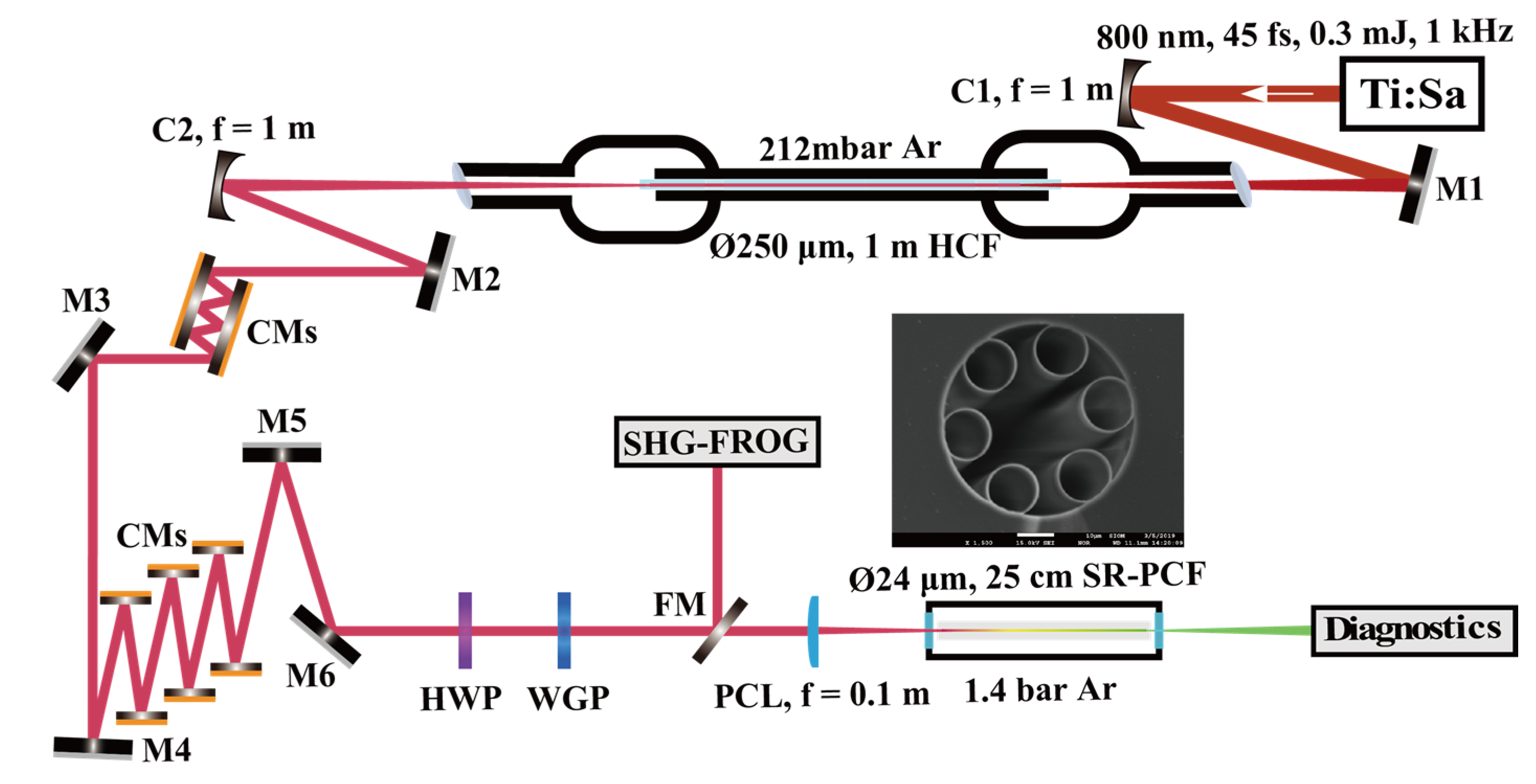
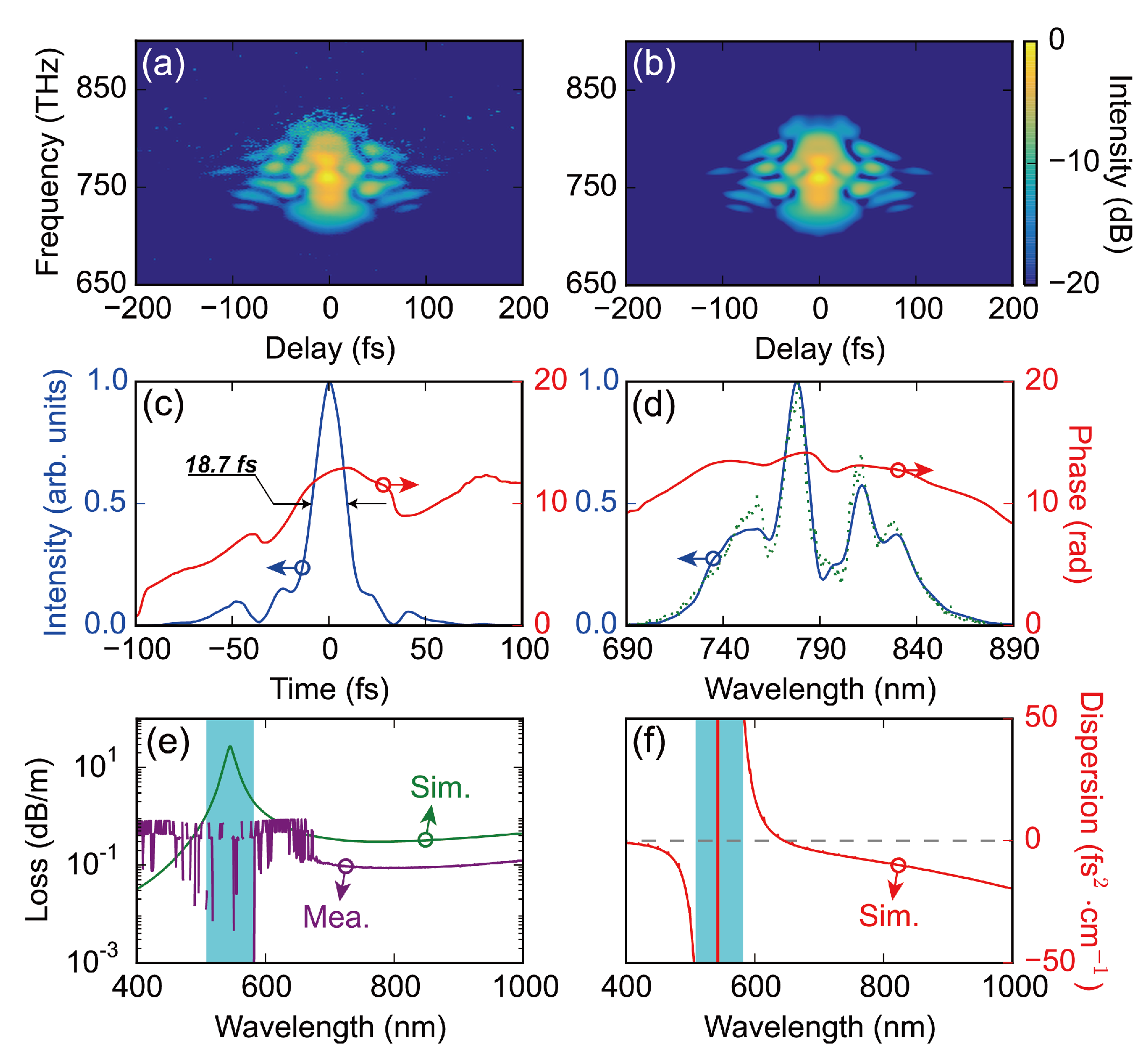
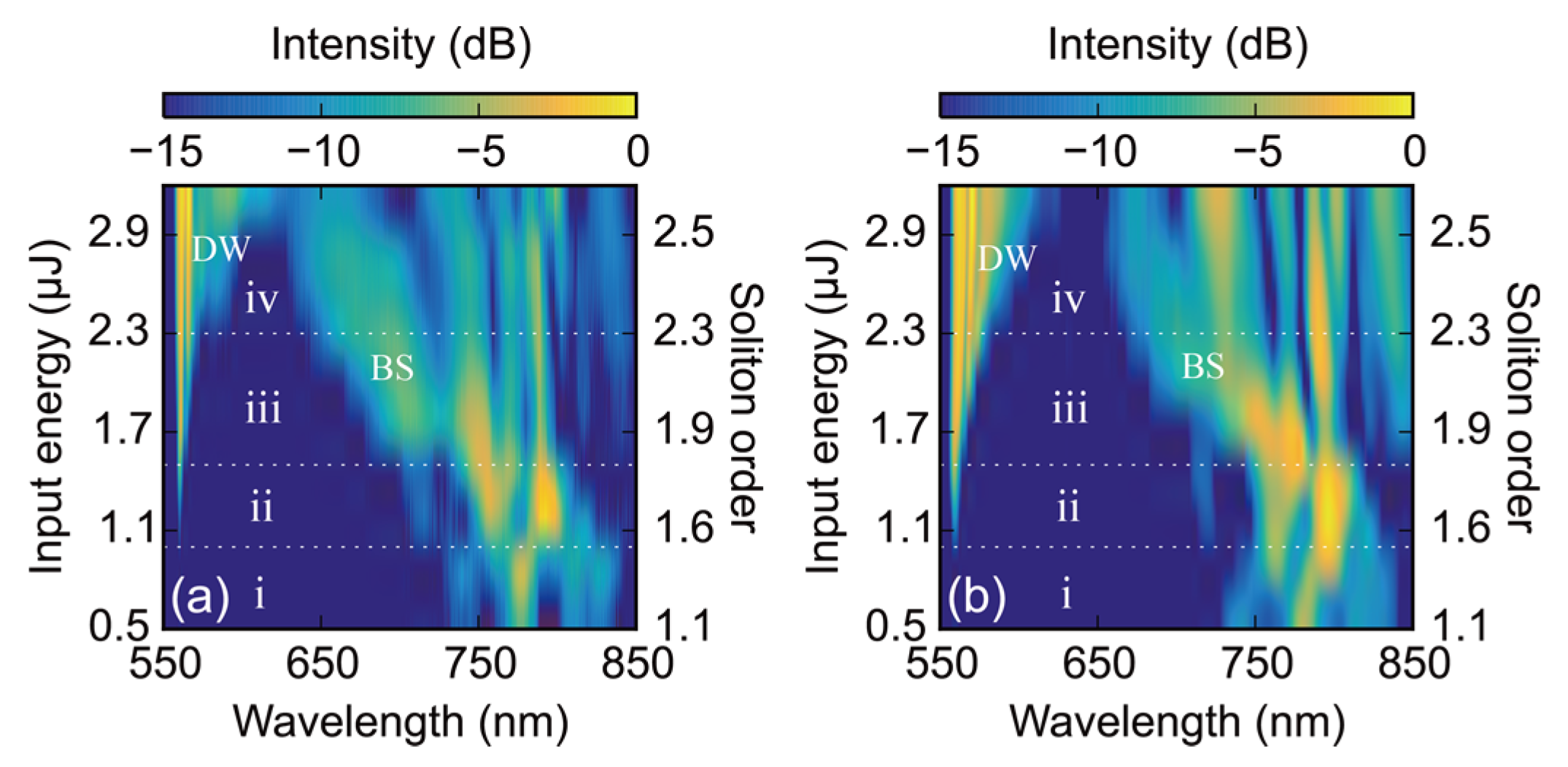
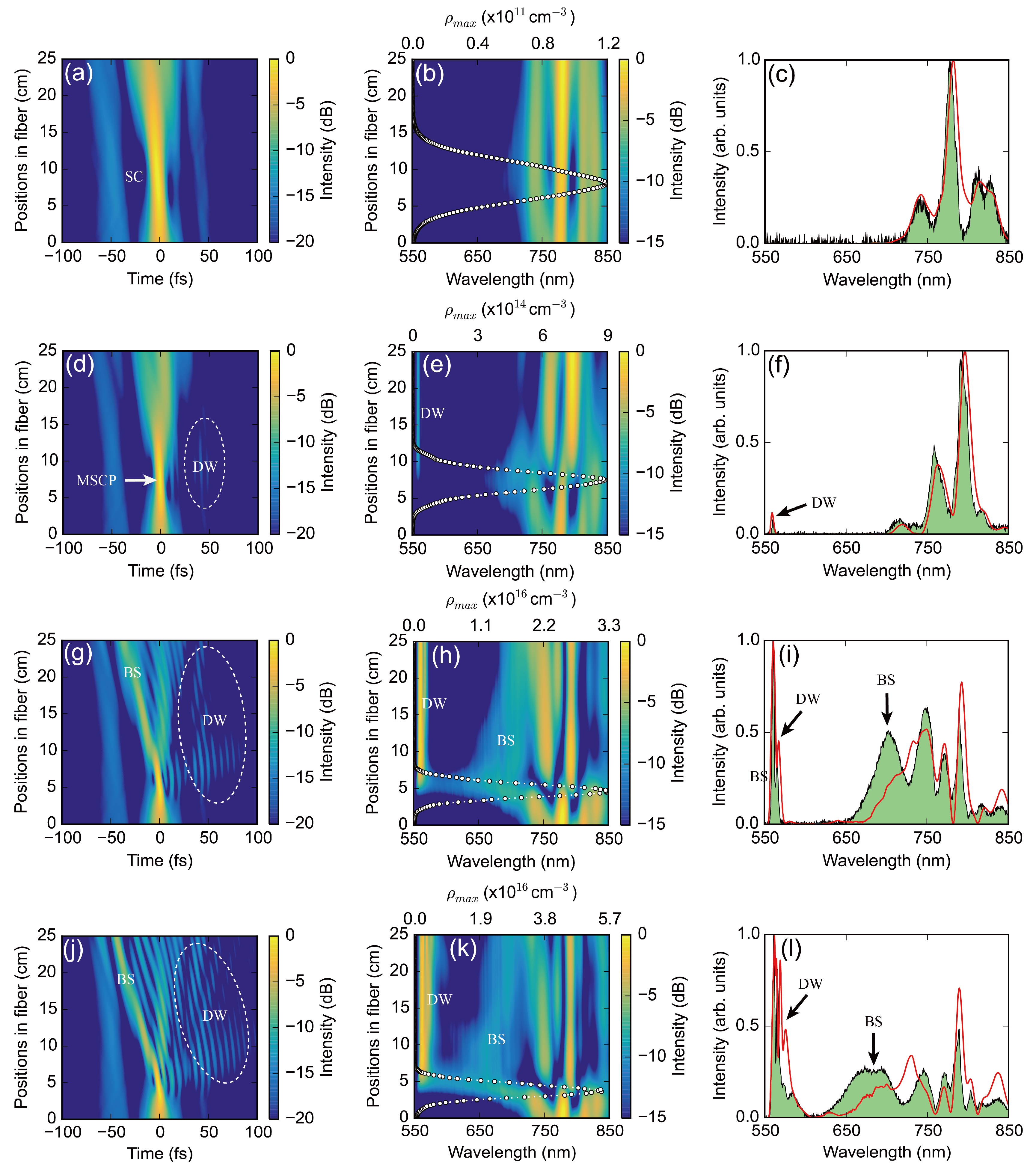
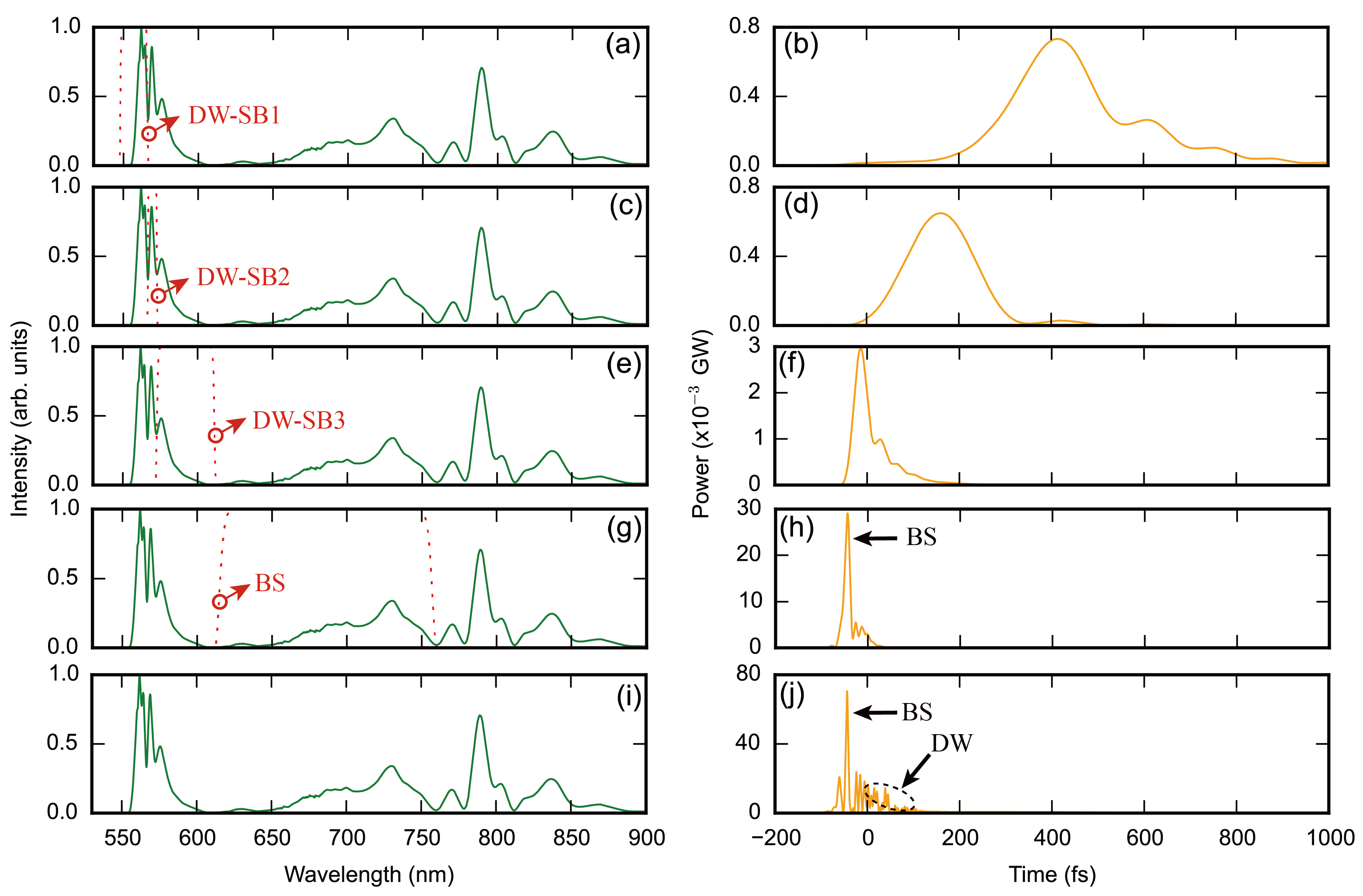
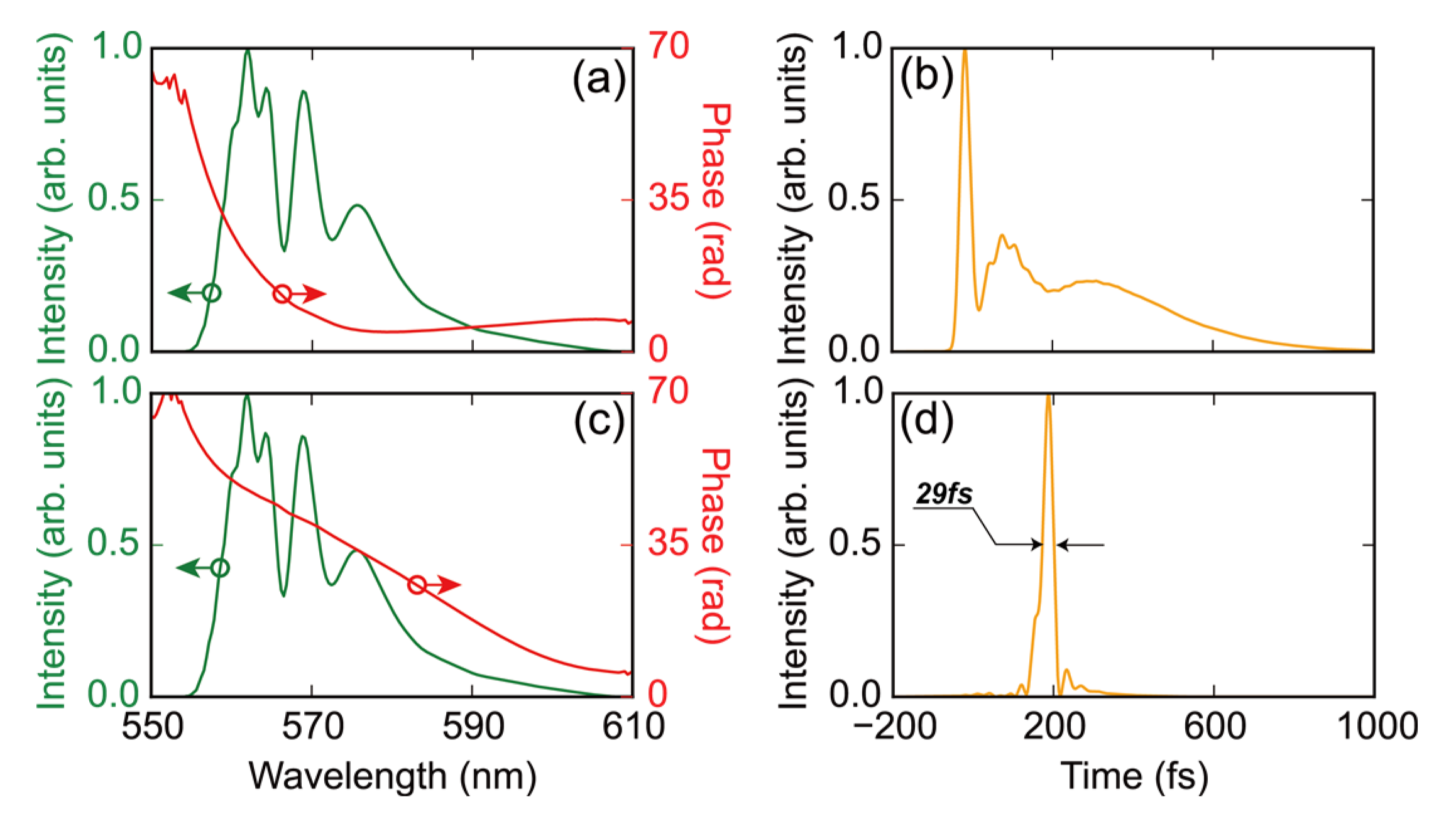
Publisher’s Note: MDPI stays neutral with regard to jurisdictional claims in published maps and institutional affiliations. |
© 2021 by the authors. Licensee MDPI, Basel, Switzerland. This article is an open access article distributed under the terms and conditions of the Creative Commons Attribution (CC BY) license (http://creativecommons.org/licenses/by/4.0/).
Share and Cite
Fu, J.; Chen, Y.; Huang, Z.; Yu, F.; Wu, D.; Pan, J.; Zhang, C.; Wang, D.; Pang, M.; Leng, Y. Photoionization-Induced Broadband Dispersive Wave Generated in an Ar-Filled Hollow-Core Photonic Crystal Fiber. Crystals 2021, 11, 180. https://doi.org/10.3390/cryst11020180
Fu J, Chen Y, Huang Z, Yu F, Wu D, Pan J, Zhang C, Wang D, Pang M, Leng Y. Photoionization-Induced Broadband Dispersive Wave Generated in an Ar-Filled Hollow-Core Photonic Crystal Fiber. Crystals. 2021; 11(2):180. https://doi.org/10.3390/cryst11020180
Chicago/Turabian StyleFu, Jianhua, Yifei Chen, Zhiyuan Huang, Fei Yu, Dakun Wu, Jinyu Pan, Cheng Zhang, Ding Wang, Meng Pang, and Yuxin Leng. 2021. "Photoionization-Induced Broadband Dispersive Wave Generated in an Ar-Filled Hollow-Core Photonic Crystal Fiber" Crystals 11, no. 2: 180. https://doi.org/10.3390/cryst11020180
APA StyleFu, J., Chen, Y., Huang, Z., Yu, F., Wu, D., Pan, J., Zhang, C., Wang, D., Pang, M., & Leng, Y. (2021). Photoionization-Induced Broadband Dispersive Wave Generated in an Ar-Filled Hollow-Core Photonic Crystal Fiber. Crystals, 11(2), 180. https://doi.org/10.3390/cryst11020180









